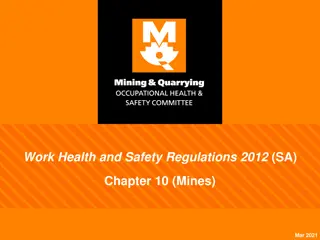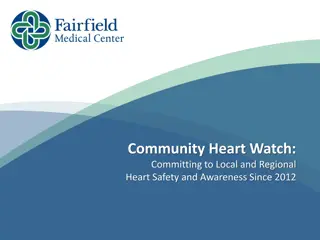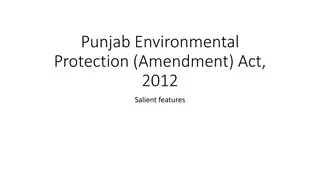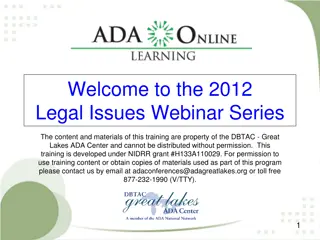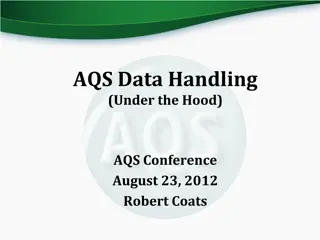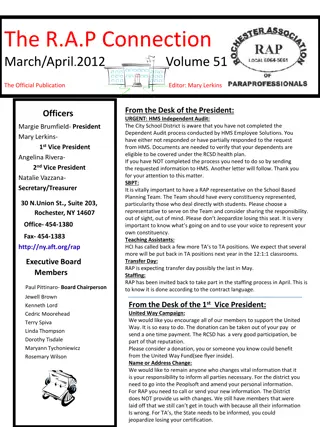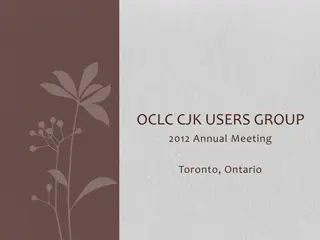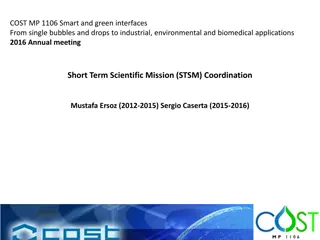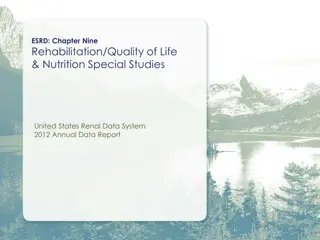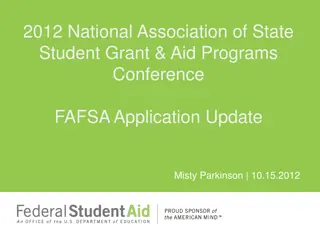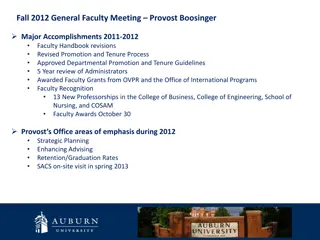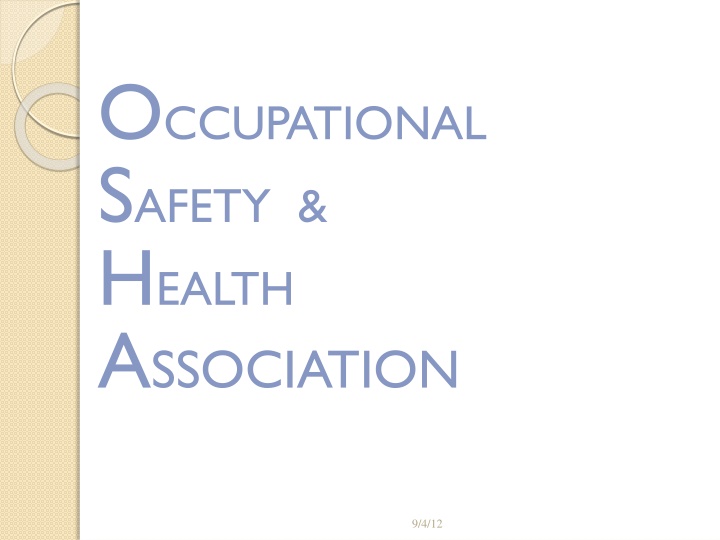
Occupational Safety and Health Association Overview
Explore the history, purpose, and key topics of the Occupational Safety and Health Association (OSHA). Learn about the Exposure Control Plan, Hazard Communication, Employee Hazard Protection, and Standard Precautions related to workplace safety. Discover essential information on bloodborne pathogens, safety measures, and training for employees. Stay informed to promote a safer work environment.
Download Presentation

Please find below an Image/Link to download the presentation.
The content on the website is provided AS IS for your information and personal use only. It may not be sold, licensed, or shared on other websites without obtaining consent from the author. If you encounter any issues during the download, it is possible that the publisher has removed the file from their server.
You are allowed to download the files provided on this website for personal or commercial use, subject to the condition that they are used lawfully. All files are the property of their respective owners.
The content on the website is provided AS IS for your information and personal use only. It may not be sold, licensed, or shared on other websites without obtaining consent from the author.
E N D
Presentation Transcript
OCCUPATIONAL SAFETY & HEALTH ASSOCIATION 9/4/12
OSHA History Initial Act Passed by Congress 1970 Amendment Passed by Congress-1990 The Purpose of establishing the The Purpose of establishing the administration was to promote the administration was to promote the safety & health of employees through safety & health of employees through out the United States out the United States 4/13/2025 M2
OSHA Topics General Safety, Fire, Electrical & Emergency Preparedness Hazard Communication Standard Precautions/Infection Control Tuberculosis Ergonomics Latex Allergy Violence in the Workplace Internal vs. External disaster 4/13/2025 M2
Exposure Control Plan ECP: employers are responsible for a written plan to inform and train employees (at no cost to the employee), what their risk level is, how risk can be decreased, safe practices, and updates in technology to minimize such. 4/13/2025 M2
Hazard Communication Exposure Control Plan Training regarding: Job function & risk categories Standard Practices-Policies & Procedures Infection Control, Blood Spills & Sharps Engineering Controls Awareness Safe Work Practices Infectious Waste Disposal 4/13/2025 M2
Employee Hazard Protection Personal Protective Equipment - Gloves, face shields, mask , gown, eye - Indications for use: body fluids that may splash, infective agents that are transmitted via air or contact Material Safety Data Sheets Immediate resources Common Causes of Injury wear 4/13/2025 M2
STANDARD PRECAUTIONS BLOODBORNE PATHOGENS: blood A GERM THAT TRAVELS IN THE BLOOD AND BODY FLUIDS THAT IS CAPABLE OF CAUSING DISEASE. 4/13/2025 M2
BLOODBORNE PATHOGEN STANDARD Covers what a bloodborne pathogen is How is it transmitted Prevention of transmission methods PPE Hand washing Sharps injury prevention Bio-hazardous waste disposal Disease prevention via vaccinations 4/13/2025 M2
Three Primary disease risks for Healthcare Workers HIV Aids HBV Hepatitis B HCV Hepatitis C Other bloodborne illnesses such as Malaria, Rocky Mountain Tick Fever, Crutzfeldt-Jacob Disease, Syphilis & West Nile Virus are risk factors but not considered by OSHA to be workplace risks. 4/13/2025 M2
SYMPTOMS HIVHepatitis B Hepatitis C fatigue fatigue fatigue Loss of appetite Loss of appetite Loss of appetite N&V N&V N&V jaundice jaundice Swollen lymph nodes Night sweats Amber, tea colored urine Amber, tea colored urine Gray stools Lingering infection Gray stools Enlarged liver Enlarged liver 4/13/2025 M2
Hepatitis B Vaccination Hep B only work-related Bloodborne disease for which vaccine is available OSHA requirement in Exposure Control Plan 97% Effective Ten Year Revaccination Recommended 4/13/2025 M2
TUBERCULOSIS Increase in Resistance Transmission is by air and respiratory inhalation At Risk: TB exposed & diminished immune system Infected vs Infectious 4/13/2025 M2
TB: Employee Protection Specific respiratory masks are required and must be correctly fitted to be effective (N95, N99, N100, R95, R99, R100, P95, P99, and P100 filters (including disposable respirators) Negative airflow is required for respiratory isolation. TB testing performed routinely on healthcare workers 4/13/2025 M2
ERGONOMICS DEFINITION: (Body Mechanics) this includes good posture, good lifting & transferring techniques of items & people, positioning changes when sitting/standing in one place for long periods of time, good resting/relaxing techniques, and the efficient organization of work areas and supplies. Use mechanical devices/aides when indicated Utilize proper lifting techniques Maintain a healthy back with exercise 4/13/2025 M2
Chemical Exposure Chemical exposure can be a result of inhalation, direct contact or ingestion. Chemical accidents occur when people do not read or do not follow the directions for using or mixing of a chemical agent 4/13/2025 M2
Radiation Exposure Radiation exposure is determined by length of time exposed, distance from the radiation source and the amount of the radiation dose. 4/13/2025 M2
Latex Sensitivity Latex allergies on the rise Causative agents Type I allergic reaction Hives, itching, teary eyes , runny nose, respiratory distress Other allergies precipitate latex allergy Latex sensitive persons need to avoid balloons,condoms,rubber bands, shoe soles 4/13/2025 M2
VIOLENCE IN THE WORKPLACE Increased awareness of potential dangers Increase personal safety, i.e. car park safety Report suspicious persons to security promptly Bomb Threat: In the event of a phoned threat, gather as much information as possible from caller-write it down and pass it on to security and police. 4/13/2025 M2
Code Pink Code Pink may be used for abduction of an infant - Doors are locked; employees are posted in hallways and at stairwells - Suspicious people are stopped and questioned 4/13/2025 M2
Tornado Warning vs. Watch Tornado Watch means weather is conducive to tornado formation Tornado Warning means a tornado has been sighted within the vicinity Move patients away from windows and into hallways with solid walls Close curtains and doors to prevent flying debris. 4/13/2025 M2
Internal vs. External Disastor An event within the facility is an internal disaster- tornado, bomb threat, fire, etc External disaster occurs in community but impacts facility-mass shooting, bus accident with multi victims, apartment fire, etc. Facilities have policies in place on how to deal with incidents internally or externally 4/13/2025 M2
Summary OSHA History Ergonomics General Safety Standard Precaution & Infection Control Hazard Communication Tuberculosis Latex Sensitivity Workplace Violence 4/13/2025 M2



